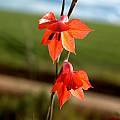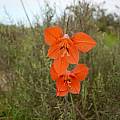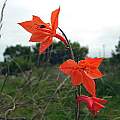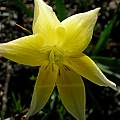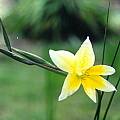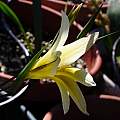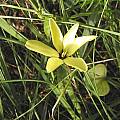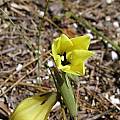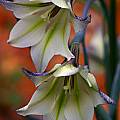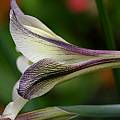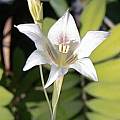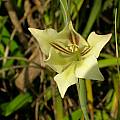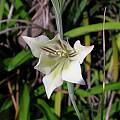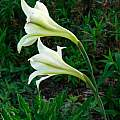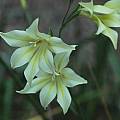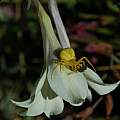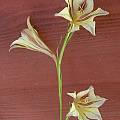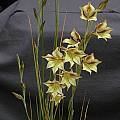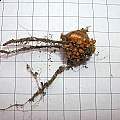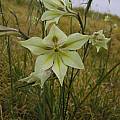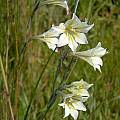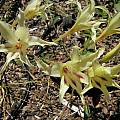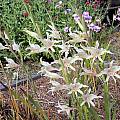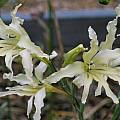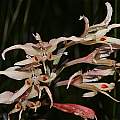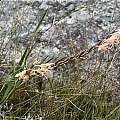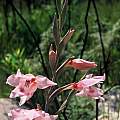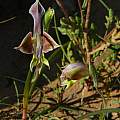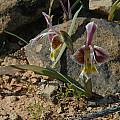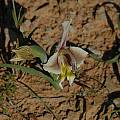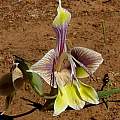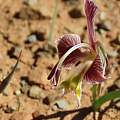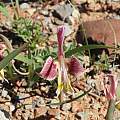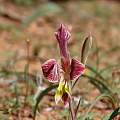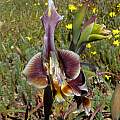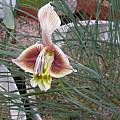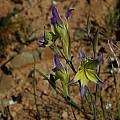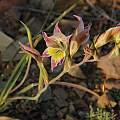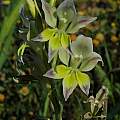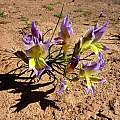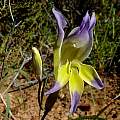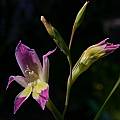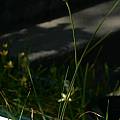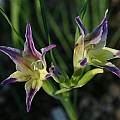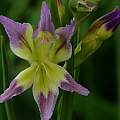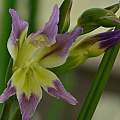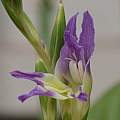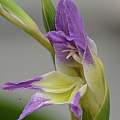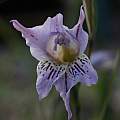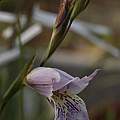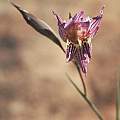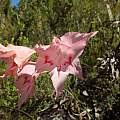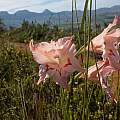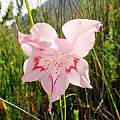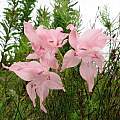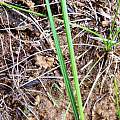Winter rain Gladiolus like their winters wet and mild and may need a dry summer dormancy. They are often less hardy, reaching down to USDA zone 8 at most.
Page 1: G. abbreviatus... Page 2: G. bonaspei... Page 3: G. carmineus... Page 4: G. debilis... Page 5: G. gracilis... Page 6: G. inflatus... Page 7: G. maculatus... Page 8: G. mutabilis... Page 9: G. pulcherrimus... Page 10: G. saccatus...
Gladiolus teretifolius Goldblatt & M.P.de Vos (syn. Homoglossum muirii) is a rare plant found in the southern Cape growing in heavy soils in renosterveld. It has scarlet flowers and blooms fall to winter. Photos taken by Cameron McMaster in the Overberg, Bredasdorp and Agulhas.
Gladiolus trichonemifolius Ker Gawl. is found on wet sandy flats in the winter rainfall areas. It flowers in late winter to early spring and is cream to yellow with brown lines on the lower tepals and a darker yellow center.
Photos below show the typical form. The first photo by Alan Horstmann, the second by Mary Sue Ittner, and the last two by Michael Mace.
This species now includes a form formerly known as Gladiolus citrinus Klatt, which has a cupped perianth and a dark purple blotch in the center. It's very different from the typical form. The first three photos from Rod Saunders and Bob Rutemoeller show the former Gladiolus citrinus.
Gladiolus tristis L. is one of the more widespread species in the winter rainfall regions. It is often found in dense colonies on damp flats, but can be found near sea level to high elevations. It is nicknamed the marsh Afrikaner and can be found in marshy areas, but also on banks above streams, in poorly drained seeps or on cool south-facing slopes. The time of bloom varies by populations. It produces a lot of little cormlets around the base of the corm and can spread to other pots if soil is reused. This species also spreads by seed, and has been known to naturalize in habitats it likes such as gardens and botanical gardens. It's not a thug, but be aware of what you're doing if you put it in the ground in a mediterranean climate. Plants grow to about 2 feet (~0.7m) tall with slender, spiraling leaves about the diameter of a chopstick. It is easily grown in a well-drained mix, full sun, and summer dry dormancy. Give it a dilute or slow release fertilizer high in phosphorous when in active growth.
Photos 1-2 were taken by Sheila Burrow, 3 by Doug Westfall, 4-5 by Alan Horstmann and 6 by Kathleen Sayce.
I grow two forms. One is light yellow and blooms March to April. It is only slightly fragrant at night. It is the first one pictured below. In the second photo there is a spider on the flowers, catching what seems to be a fly pollinator. The second form pictured below in photos 3-4 is a late blooming form, once known as Gladiolus tristis var. aestivalis, but not recognized as a variety by Goldblatt and Manning. These plants were grown from IBSA seed collected near Paarl where they grow in wet boggy areas that are shady. This form is very fragrant at dusk/night when the flowers are open wider as well. The last photo shows one corm on a 1 cm grid with all the cormlets showing how many new plants are possible from one corm. Photos by Mary Sue Ittner .
Habitat shots taken by Bob Rutemoeller September 2003 at Drayton and Cameron McMaster at Bredasdorp.
Gladiolus undulatus is a late spring summer flowering plant found on marshy sandstone slopes in the northwest and southwest Cape. It has whitish to cream flowers with pink diamonds on the lower tepals. Although it is similar to Gladiolus carneus, it has a much longer tube with wavy tepals. Given the right conditions in some areas outside of South Africa this species has naturalized. The first three photos were taken by Mary Sue Ittner of flowers blooming various years in June in northern California. Photos 4-5 were taken in habitat by Andrew Harvie near Bainskloof. The last photo was taken by Rod Saunders.
Gladiolus uysiae L.Bolus ex G.J.Lewis is brownish purple with dark veining and fragrant. It flowers late winter to early spring and can be found on clay slopes in renosterveld. Photos 1-4 were taken in habitat near Middelpos in the Roggeveld by Mary Sue Ittner, Bob Rutemoeller and Cameron McMaster.
The first three photos were taken by Alan Horstmann in 2023 near Middelpos. The fourth photo was taken by Cameron McMaster near Nieuwoudtville September 2011. The last photo taken by Bob Rutemoeller shows one grown by Gordon Summerfield in South Africa flowering September 2003
Gladiolus venustus G.J.Lewis has flowers that are shades of purple to pink and sometimes dull yellow with yellow markings on the lower half of the lower tepals. It is widely distributed across the interior of the winter rainfall areas of southern Africa where it is found in dry habitats on clay and sandstone slopes. The primary pollinators are long tongued bees. It can be confused with Gladiolus scullyi and it has been included in that species at one time but it usually more colorful than that species which is usually greenish cream to yellow brown or beige and more highly scented. The dorsal tepal on Gladiolus scullyi is also more horizontal, inclined over the stamens and the upper two lateral tepals curve outward in an arc. But the distinctions are sometimes difficult to tell, especially in areas where they both grow. An example of this difficulty is shown in the third picture which I suppose could be either species. The first two photos by Mary Sue Ittner and Bob Rutemoeller were taken September 2006 in the Roggeveld. The third photo from Mary Sue Ittner was taken near Nieuwoudtville. The last two photos were taken by Cameron McMaster September 2011 near Middelpos in the Roggeveld.
Photos below were taken by Bob Werra.
Photos below were taken by Arnold Trachtenberg.
Gladiolus violaceolineatus G.J.Lewis grows in the Cederberg Mountains, where it is generally found on south-facing sandstone slopes that remain moist throughout the winter, according to Goldblatt & Manning. The flower is pale violet with dark purple lines on the tepals, which are often narrower and longer than shown in these photos. The flowers are sweet-smelling, and reportedly bloom in early spring, although they may bloom a bit later at higher elevations. The first two photos by Michael Mace. The last photo from Rod Saunders.
Gladiolus virgatus Goldblatt & Manning is restricted to cool, well watered slopes of the coastal ranges of the southwestern Cape. Poorly collected, it has been found in clay soil on ground covered with scattered sandstone boulders. Growing from 30 to 60 cm high, it has linear leaves with slightly thickened margins and midribs. The pale to deep pink or nearly white large unscented flowers are marked on the lower tepals with a spear shaped whitish median streak edged with a reddish v shaped mark, speckled in the throat and are in a two to four flowered inclined spike. The dorsal tepal is inclined over the stamens. This species flowers September-November. The first two photos from Rachel Saunders taken in the Helderberg Nature Reserve. The next three photos from iNaturalist taken by linkie in the same place in November and shared under a CC BY-NC license.
Page 1: G. abbreviatus... Page 2: G. bonaspei... Page 3: G. carmineus... Page 4: G. debilis... Page 5: G. gracilis... Page 6: G. inflatus... Page 7: G. maculatus... Page 8: G. mutabilis... Page 9: G. pulcherrimus... Page 10: G. saccatus...
